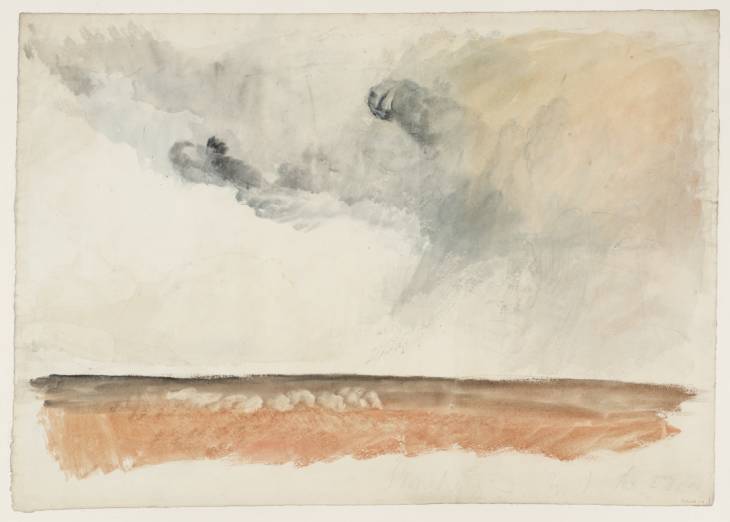Joseph Mallord William Turner Stonehenge c.1827
Joseph Mallord William Turner,
Stonehenge
c.1827
Joseph Mallord William Turner 1775–1851
Stonehenge c.1827
D25123
Turner Bequest CCLXIII 1
Turner Bequest CCLXIII 1
Watercolour and pencil on white wove paper, 346 x 488 mm
Inscribed by Turner ‘Stonehenge no 1 [?XRS] 2 done’ bottom right
Inscribed in red ink ‘1’ bottom right
Blind-stamped with Turner Bequest monogram towards bottom right
Stamped in black ‘CCLXIII – 1’ bottom right
Inscribed by Turner ‘Stonehenge no 1 [?XRS] 2 done’ bottom right
Inscribed in red ink ‘1’ bottom right
Blind-stamped with Turner Bequest monogram towards bottom right
Stamped in black ‘CCLXIII – 1’ bottom right
Accepted by the nation as part of the Turner Bequest 1856
Exhibition history
1963
Turner Watercolors from The British Museum: A Loan Exhibition Circulated by the Smithsonian Institution, National Gallery of Art, Washington, DC, September–October 1963, Museum of Fine Arts of Houston, Texas, November 1963, M.H. de Young Memorial Museum, San Francisco, December 1963–January 1964, Cleveland Museum of Art, Ohio, January–March 1964, William Rockhill Nelson Gallery of Art, Kansas City, Missouri, March–April 1964, Brooklyn Museum, New York, May 1964, National Gallery of Canada, Ottawa, June–July 1964 (42, as ‘On Salisbury Plain, near Stonehenge’).
1975
Turner in the British Museum: Drawings and Watercolours, Department of Prints and Drawings, British Museum, London, May 1975–February 1976 (95, reproduced, as ‘Sheep grazing on Salisbury Plain’, ?c.1825).
1991
Turner: The Fourth Decade: Watercolours 1820–1830, Tate Gallery, London, January–May 1991 (37, as ‘Stonehenge: preparatory study’, c.1826–7).
2002
Turner’s Picturesque Travels: Engraved Views of Britain, Tate Britain, London, March–August 2002 (no catalogue).
2007
Colour and Line: Turner’s Experiments [second hang], Tate Britain, London, November 2007–October 2008 (no catalogue).
References
1909
A.J. Finberg, A Complete Inventory of the Drawings of the Turner Bequest, London 1909, vol.II, p.814, CCLXIII 1, as ‘“Stonehenge” – “No. 1 & 2 done.”’. c.1820–30.
1975
Andrew Wilton, Turner in the British Museum: Drawings and Watercolours, exhibition catalogue, Department of Prints and Drawings, British Museum, London 1975, p.66 no.95, reproduced, as ‘Sheep grazing on Salisbury Plain’. ?c.1825.
1979
Andrew Wilton, J.M.W. Turner: His Life and Work, Fribourg 1979, p.395 under no.811.
1980
Pierre Rouve, Turner, étude de structures, Paris 1980, reproduced in colour p.147, as ‘Brebis sur la plaine de Salisbury’. c.1825.
1997
Eric Shanes, Turner’s Watercolour Explorations 1810–1842, exhibition catalogue, Tate Gallery, London 1997; pp.13, 15, 16, 32, 95, 104 (p.32, notes 12–14, p.95 Appendix I under ‘England and Wales Series’, as Stonehenge subject. c.1828, p.104 Appendix II, as ‘Study: Stonehenge’, fig.1).
This colour study has long been recognised as relating to the watercolour of about 1827 (Salisbury and South Wiltshire Museum),1 engraved as Stone Henge in 1829 for the Picturesque Views in England and Wales (Tate impressions: T04548, T04549, T06083).2 This identification was largely facilitated by Turner’s inscription ‘Stonehenge no 1 [?XRS] 2 done’; the only elaborations to the basic setting of Salisbury Plain below billowing clouds are a cluster of roughly vertical and horizontal pencil lines above the horizon towards the right, lightly indicating the stones of the ancient Wiltshire monument, and pale shapes lifted from the dark was below the horizon which prefigure the sheep in the finished design. Shanes notes that ‘were it not for the inscription and subtle resemblance of cloud forms’ it would have been difficult to make the connection.3
A detailed discussion of Turner’s Stonehenge sketches and subsequent works appears in this catalogue’s introduction to the Stonehenge sketchbook (Tate; CXXV b),4 used on his 1811 tour of the West Country. As has been noted elsewhere,5 the dramatic England and Wales rendition of the monument in a thunder-storm, with a shepherd and his flock struck by lightning, is crowded with inaccurately drawn stones, bearing a very inexact resemblance to the place and to the attentive drawings made at the site.
Dismissing earlier readings of ‘&’ and ‘and’, Shanes interprets the characters inscribed between Turner’s ‘1’ and ‘2’ as ‘XRS’, noting the latter as a cipher for the name of Christ, linking it to the shepherd imagery of the finished design and the thematically associated England and Wales watercolour of Salisbury, Wiltshire of about 1828 (also Salisbury and South Wiltshire Museum),6 engraved in 1830 (Tate impression: T04586).7
An even sparser ‘colour beginning’ (Tate D25159; Turner Bequest CCLXIII 37) has also been related to the Stonehenge composition. See also the introductions to the present subsection of identified subjects and the overall England and Wales ‘colour beginnings’ grouping to which this work has been assigned.
See Finberg 1909, II, p.814, and later sources including Wilton 1975, p.66, Wilton 1979, p.395, and Shanes 1997, pp.13, 15, 16, 95, 104.
Verso:
Blank, save for inscriptions: inscribed by Turner in pencil ‘[?1]’ circled towards centre left, ascending or descending vertically; in pencil ‘AB 94 P’ and ‘CCLXIII 1’ top left, upside down; and stamped in black with Turner Bequest monogram above ‘CCLXIII – 1’ bottom left.
Blank, save for inscriptions: inscribed by Turner in pencil ‘[?1]’ circled towards centre left, ascending or descending vertically; in pencil ‘AB 94 P’ and ‘CCLXIII 1’ top left, upside down; and stamped in black with Turner Bequest monogram above ‘CCLXIII – 1’ bottom left.
The ‘AB’ number corresponds with the endorsement on one of the parcels of works sorted by John Ruskin during his survey of the Turner Bequest, in this case classified by him as ‘Colour effects. Finer’.1
Matthew Imms
March 2013
How to cite
Matthew Imms, ‘Stonehenge c.1827 by Joseph Mallord William Turner’, catalogue entry, March 2013, in David Blayney Brown (ed.), J.M.W. Turner: Sketchbooks, Drawings and Watercolours, Tate Research Publication, December 2013, https://www

